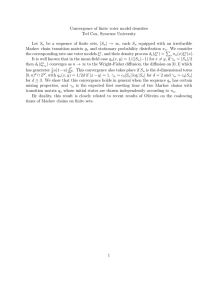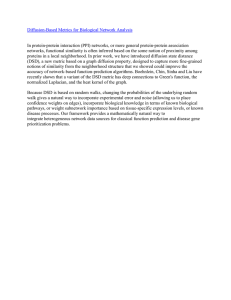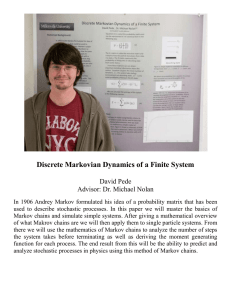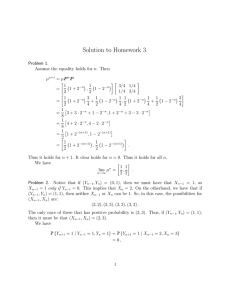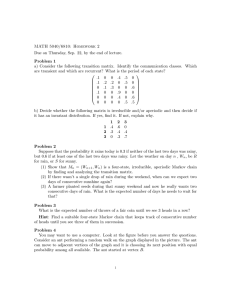A Note on Diffusion State Distance
advertisement
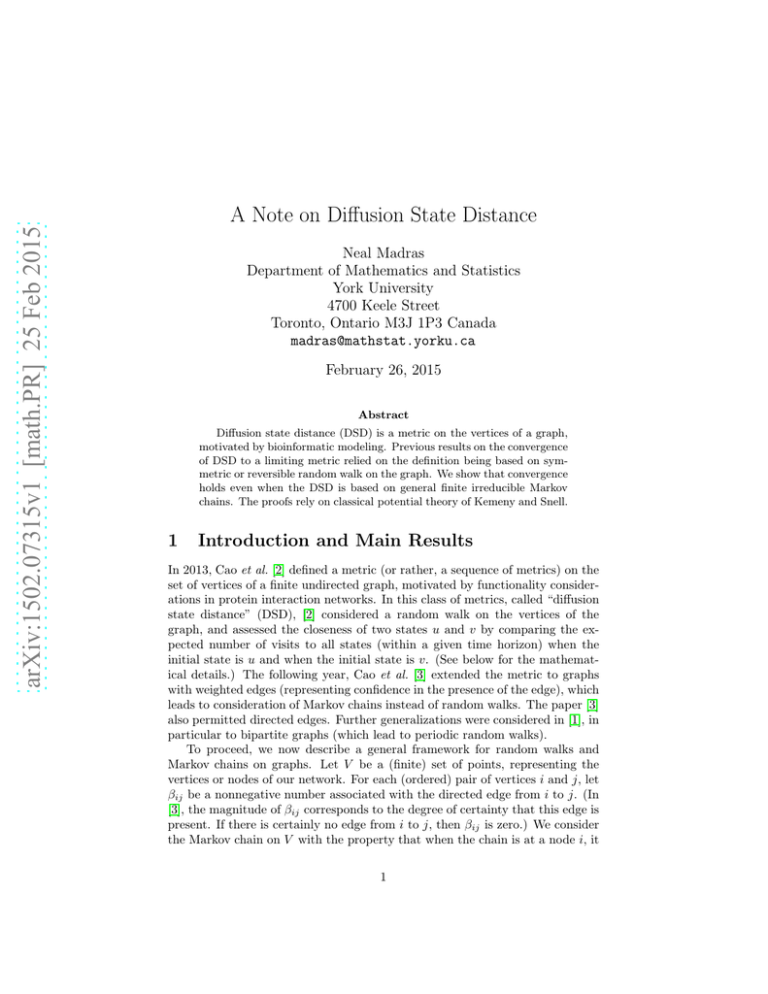
arXiv:1502.07315v1 [math.PR] 25 Feb 2015
A Note on Diffusion State Distance
Neal Madras
Department of Mathematics and Statistics
York University
4700 Keele Street
Toronto, Ontario M3J 1P3 Canada
madras@mathstat.yorku.ca
February 26, 2015
Abstract
Diffusion state distance (DSD) is a metric on the vertices of a graph,
motivated by bioinformatic modeling. Previous results on the convergence
of DSD to a limiting metric relied on the definition being based on symmetric or reversible random walk on the graph. We show that convergence
holds even when the DSD is based on general finite irreducible Markov
chains. The proofs rely on classical potential theory of Kemeny and Snell.
1
Introduction and Main Results
In 2013, Cao et al. [2] defined a metric (or rather, a sequence of metrics) on the
set of vertices of a finite undirected graph, motivated by functionality considerations in protein interaction networks. In this class of metrics, called “diffusion
state distance” (DSD), [2] considered a random walk on the vertices of the
graph, and assessed the closeness of two states u and v by comparing the expected number of visits to all states (within a given time horizon) when the
initial state is u and when the initial state is v. (See below for the mathematical details.) The following year, Cao et al. [3] extended the metric to graphs
with weighted edges (representing confidence in the presence of the edge), which
leads to consideration of Markov chains instead of random walks. The paper [3]
also permitted directed edges. Further generalizations were considered in [1], in
particular to bipartite graphs (which lead to periodic random walks).
To proceed, we now describe a general framework for random walks and
Markov chains on graphs. Let V be a (finite) set of points, representing the
vertices or nodes of our network. For each (ordered) pair of vertices i and j, let
βij be a nonnegative number associated with the directed edge from i to j. (In
[3], the magnitude of βij corresponds to the degree of certainty that this edge is
present. If there is certainly no edge from i to j, then βij is zero.) We consider
the Markov chain on V with the property that when the chain is at a node i, it
1
chooses its next node with probability proportional to the weights on the edges
leading out of i. That is, the one-step transition probabilities for the Markov
chain are
βij
pij = P
for i, j ∈ V .
(1)
k∈V βik
(We assume that there is no i for which the denominator in Equation (1) is 0.)
The case of a classical random walk on a directed graph (with no weights) is
obtained by requiring each βij to equal 0 or 1, according to whether or not there
is an edge from i to j. The case of a weighted undirected graph is obtained by
requiring βij = βji for every i and j in V ; this is the case assumed by Chung
and Yao [4], which in turn was built upon by [1].
Note that the form of Equation (1) is completely general, since the transition
probabilities pij of any
P given Markov chain satisfy (1) if we let βij be pij for
every i and j (since k pik = 1 in any Markov chain).
We shall denote the set of states of the Markov chain by V = {1, . . . , n}. We
shall write P for the (one-step) transition probability matrix with entries pij .
(l)
For l = 0, 1, 2, . . ., we write pij for the l-step transition probabilities, which are
the entries of the matrix P l . We say that the Markov chain (or P ) is irreducible
if it is possible to get from every state to every other state; that is, for every
(l)
pair of states i and j, there is an l ≥ 0 such that pij > 0. We say that an
irreducible Markov chain (or P ) is periodic if there is an integer d ≥ 2 such that
(l)
p11 = 0 whenever l is not a multiple of d; in this case d is called the period. We
say that the chain is aperiodic if it is not periodic.
Throughout this paper, except for the generalizations discussed in Section 3,
we shall assume that P is the transition probability matrix of a finite irreducible
Markov chain.
1.1
The Aperiodic Case
In this section, we shall assume that P is aperiodic as well as finite and irreducible.
Let π be the equilibrium
distribution of P , i.e. the row vector (π1 , . . . , πn )
P
such that πP = π and
πi = 1. (This is written π T in [2] and α in [6]). Under
our assumptions, π exists and is unique. Moreover, the limit matrix
W := lim P k
k→∞
(2)
exists, and Wij = πj for all states i and j. (This is called W in [2], and A in [5]
and [6].) Writing ~1 to denote the column vector with all entries equal to 1, we
have W = ~1π.
For states u and v and any integer k ≥ 0, we follow [2] and define
He(k) (u, v) =
k
X
l=0
2
(l)
puv
.
Thus He(k) (u, v) is the expected number of visits to v within the first k steps
(k)
of the chain, given that the chain starts at u. (This is called Nuv in [6], and
(k+1)
Mu [ȳv
] in [5].)
Proposition 1 For an aperiodic finite irreducible Markov chain:
(a) The matrix Z defined by
Z =
∞
X
(P − W )k
k=0
exists and equals (I − P + W )−1 . (Note: [2] writes D for P − W ).
(b) For all states u, v, and w, we have
lim He(k) (u, w) − He(k) (v, w) exists and equals Zuw − Zvw .
k→∞
Remark 2 Part (b) agrees with Lemma 3 of [2], since Zuw − Zvw = (bTu −
bTv )Z bw (where bi is the column vector having ith entry equal to 1 and all other
entries equal to 0.)
We now define the diffusion state distance metrics. For states u and v and
integers k ≥ 0, let
DSD
(k)
(u, v) =
n
X
|He(k) (u, w) − He(k) (v, w)| .
(3)
w=1
Lemma 1 of [2] shows that DSD(k) is a metric for aperiodic irreducible random
walks; see Section 3 below for discussion and generalization. We also write
DSD(∞) (u, v) = lim DSD(k) (u, v)
k→∞
(4)
if this limit exists.
Corollary 3 Consider an aperiodic finite irreducible Markov chain. Then the
limit (4) exists, and
X
DSD(∞) (u, v) =
|Zuw − Zvw | .
(5)
w
Moreover, DSD(∞) is a metric.
Corollary 3 was proven in [2] for undirected unweighted graphs (βij = βji ∈
{0, 1}), and in [1] for graphs with symmetric weights (βij = βji ). (Observe that
the Green’s function matrix G in [1] is precisely our Z.) Both proofs rely on the
diagonalization of the matrix P , which holds because the symmetry of weights
implies that P can be expressed as a self-adjoint operator (equivalently, that
3
the Markov chain is reversible). In contrast, the proofs in the present paper
rely on the classical potential theory for general finite (and countable) Markov
chains in [5] and/or [6].
(k)
We remark that [1] also considers the DSDq metric for q ≥ 1, defined by
replacing the l1 norm on the right hand side of Equation (3) by the lq norm, i.e.
!1/q
n
X
(k)
(k)
(k)
q
DSDq (u, v) =
.
|He (u, w) − He (v, w)|
w=1
The extension of Corollary 3 and Equation (4) to DSDq is immediate.
1.2
The Periodic Case
In this section, we shall consider the case that P is periodic as well as finite and
irreducible. An important example is the case of a random walk on a bipartite
graph. This example was considered in [1].
As explained in Chapter 5.1 of [5], the relevant theory for aperiodic Markov
chains extends to the periodic case with some modifications. There is a unique
equilibrium probability distribution π such that πP = π. We still define the
matrix W by Wij = πj . However, the limit of Equation (2) does not exist in
the usual sense, but the equation is correct for the Cesaro limit. Moreover, the
matrix I − P + W is invertible, and Proposition 1(a) holds if we interpret the
infinite sum defining Z to be the Cesaro sum.
For now, consider the general case that P is finite and irreducible (not necessarily periodic). For 0 ≤ α < 1, let Pα = αI + (1 − α)P be the “lazy Markov
chain”, which moves according to P except that with probability α it decides to
stay wherever it is for one time unit. Observe that π = πPα , so the equilibrium
distribution is independent of α, as is the matrix W . Let Zα = (I − Pα + W )−1 .
Since this is well-defined, we can use Equation (5) as our definition of DSD(∞)
for our periodic chain P , even though the limit of Proposition 1 may not exist
except in the Cesaro sense. The following result shows that this definition is
consistent with the usual definition. Observe that if 0 < α < 1, then Pα is
aperiodic (and irreducible), and so the results of Section 1.1 apply.
Proposition 4 Assume that P is finite and irreducible.
(a) For every α ∈ [0, 1), we have Zα = (1 − α)−1 (Z0 − αW ).
(b) Let DSD(∞;α) be the DSD(∞) metric of the Markov chain Pα . Then for all
states u and v,
DSD(∞;α) (u, v) = (1 − α)−1 DSD(∞;0) (u, v) .
In particular, part (b) generalizes Theorem 1 of [1] to general Markov chains. It
shows that for periodic chains, the formal definition of Equation (5) is consistent
by continuity with the (more directly motivated) definition (4) for aperiodic
chains, i.e.
lim DSD(∞;α) (u, v) = DSD(∞;0) (u, v)
α→0
4
for all u, v.
2
Proofs of Results
Proof of Proposition 1: (a) This is direct from Propositions 9-75 and 9-76(4)
of [6], or Theorem 4.3.1 of [5].
(b) This follows from Corollary 4.3.5 of [5]. Alternatively, here is a proof using
the theory for denumerable chains (see discussion at the beginning of Section 3
below). Definition 9-24 of [6] defines the matrix C by
(k)
(k)
= lim (He(k) (j, j) − He(k) (i, j))
Cij = lim (Njj − Nij )
k→∞
k→∞
whenever this limit exists. Proposition 9-771 of [6] shows that C exists for
aperiodic finite irreducible chains and that
Cij = Zjj − Zij .
It follows that
lim He(k) (u, w) − He(k) (v, w)
k→∞
=
Cvw − Cuw
=
(Zww − Zvw ) − (Zww − Zuw )
=
Zuw − Zvw .
Proof of Corollary 3: The second sentence of the corollary follows immediately from Proposition 1. To show the final sentence, observe that Equation (5)
says that DSD(∞) (u, v) is the l1 distance between rows u and v of the matrix
Z. Since Z is invertible (by Proposition 1(a)), it must have distinct rows. It
follows immediately that DSD(∞) is a metric.
Proof of Proposition 4: By Theorem 5.1.3 of [5], we have Z ~1 = ~1 and
πZ = π, where Z denotes either Zα or Z0 . Therefore
ZW
WZ
= Z ~1π = ~1π = W
and
~
~
= 1πZ = 1π = W .
(6)
(7)
Therefore we have
I = Zα (I − Pα + W )
= Zα ((1 − α)(I − P + W ) + αW )
= (1 − α)Zα Z0−1 + αZα W
= (1 − α)Zα Z0−1 + αW
[by Eq. (6)] ,
which yields
Z0 = (1 − α)Zα + αW Z0 = (1 − α)Zα + αW
[by Eq. (7)].
1 To explain the notation of [6] in this proposition: E is the matrix of all 1’s, and Z
dg is
the diagonal matrix obtained from Z by making all off-diagonal entries 0.
5
Part (a) follows immediately.
Next, recall the observation and notation of Remark 2 above. By this and
Equation (5), we see that part (b) will follow if we can prove that γZα =
(1 − α)−1 γZ0 , where γ = bTu − bTv . But this is a direct consequence of part (a)
and the fact that γW = γ~1π = 0.
3
Some Generalizations
Since much of the potential theory for finite Markov chains in [5] also extends
to countable chains [6], it is of theoretical interest to consider whether DSD
theory extends to chains with countably many states. Our proof of Proposition
1 using results of [6] shows that this proposition extends to Markov chains that
are strong ergodic (i.e. chains that are positive recurrent and have the property
that for all states i and j, the expected square of the time to reach j [when
starting from i] is finite); in [6], see Section 9.5, p. 274, as well as Definition
9-71. However it is less clear whether Corollary 3 holds in this case, since even
the convergence of the infinite sum is not obvious.
Finally, we show that DSD(k) is a metric for every finite or countable Markov
chain except for some very special cases. For one counterexample, consider the
irreducible Markov chain with states V = {1, 2, 3, 4} such that p12 = p13 = 0.5,
p24 = p34 = p41 = 1, and pij = 0 otherwise. It is not hard to check that
He(2) (1, i) = He(2) (4, i) for every i, and so DSD(2) is not a metric. Note that
this chain has period 3. The next result shows that all counterexamples have
features in common with this example.
Proposition 5 Let P be the matrix of a (finite or countable) Markov chain,
and let k be a finite nonnegative integer. Assume that there do not exist two
(t)
(k+1)
(k+1)
= 1 and pij > 0 for some t.
= pjj
distinct states i and j such that pii
Then DSD(k) is a metric.
In particular, if P is aperiodic or if the period of P does not divide k + 1, then
(k+1)
= 1 is much more restrictive than
DSD(k) is a metric. But the condition pii
requiring the period to divide k + 1. Also note that Proposition 5 does not
assume that P is irreducible.
The following proof is essentially a streamlined generalization of the proof
of Lemma 1 in [2].
Proof of Proposition 5: Write N (t) = 1 + P + · · · + P t for t = 0, 1, . . ..
Since DSD(k) (u, v) is the the l1 distance between rows u and v of the (possibly
infinite) matrix N (k) , it suffices to show that all rows of N (k) are distinct.
Assume that u and v are distinct states such that rows u and v of N (k) are the
same. For vectors bi as defined in Remark 2, let γ = bTu − bTv . Then γN (k) = 0.
Hence γN (k) P = 0. From the definition, we have N (k) P + I = N (k) + P k+1 ,
and hence it follows that
γ = γP k+1 .
6
Multiplying this equation on the right by bu gives the equation 1 = (P k+1 )uu −
(P k+1 )vu . This can only happen if (P k+1 )uu = 1. Similarly, we deduce
(k)
(k)
(k)
(P k+1 )vv = 1. Finally, since Nuv = Nvv and Nvv ≥ Ivv = 1, there must
be a t ≤ k such that (P t )uv > 0. This contradicts the hypothesis of the proposition, and thus the proof is complete.
4
Acknowledgments
I am grateful to Lenore Cowen for helpful conversations and her enthusiasm.
This research was supported in part by a Discovery Grant from NSERC Canada.
Part of this work was done while visiting the Fields Institute for Research in
Mathematical Sciences.
References
[1] Boehnlein, E., Chin, P., Sinha, A., and Lu, L. (2014), “Computing Diffusion State Distance using Green’s Function and Heat Kernel on Graphs.”
In Algorithms and Models for the Web Graph, Bonato, A., Graham, F.C.,
and Pralat, P. (eds.), Lecture Notes in Computer Science 8882, 79–95.
(Also at arXiv:1410.3168v1.)
[2] Cao, M. et al. (2013), “Going the Distance for Protein Function Prediction: A New Distance Metric for Protein Interaction Networks”, PLoS
ONE 8(10): e76339.
[3] Cao, M. et al. (2014), “New Directions for Diffusion-Based Network Prediction of Protein Function: Incorporating Pathways with Confidence,”
Bioinformatics 30, i219–i227; doi:10.1093/bioinformatics/btu263.
[4] Chung, F. and Yao, S.-T. (2000), “Discrete Green’s functions,” J. Combinatorial Theory A, 91, 191–214.
[5] Kemeny, J.G., and Snell, J.L. (1976), Finite Markov Chains. Springer,
New York.
[6] Kemeny, J.G., Snell, J.L., and Knapp, A.W. (1976), Denumerable Markov
Chains, Springer.
7
